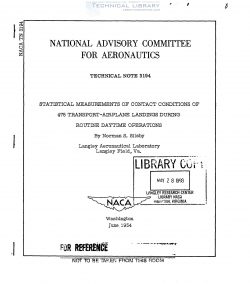naca-tn-3194
- Version
- 126 Downloads
- 1.37 MB File Size
- 1 File Count
- January 23, 2017 Create Date
- January 23, 2017 Last Updated
National Advisory Committee for Aeronautics, Technical Notes - Statistical Measurements of Contact Conditions of 478 Transport Airplane Landings During Routine Daytime Operations

Statistical measurements of contact conditions have been obtained
by means of a specially built motion—picture camera of 478 landings of
present-day transport airplanes made during routine daylight Operations
in clear air at the Washington National Airport. From these measure-
ments, sinking Speeds, rolling velocities, bank angles, and horizontal
speeds at the instant before contact have been evaluated and a limited
statistical analysis of the results has been made.
The analysis indicates that, for transport airplanes in general, the
gustyswind condition had a substantial effect in increasing the values of
sinking speed, bank angle, and rolling velocity likely to be equaled.or
exceeded once for a given number of landings but had essentially no effect
on the airspeeds at contact. Specifically, in 1,000 landings under con-
ditions of no gusts, the values of sinking speed, bank angle, and rolling
velocity (in the direction of the first wheel to touch) likely to be
equaled or exceeded once are 5.5 ft/sec, 4.80, and 4.h deg/sec, respec—
tively, for the same probability of 1 out of l, 000 landings made under
conditions with gusts, the values of these respective quantities increase
to h. 7 ft/sec, 6. 6°, and 5. 3 deg/sec. In general, the transport airplanes
landing at Washington National Airport touch down at airspeeds which have
a considerable margin above the stall; in 1 out of 1,000 landings, the
landing speed.will probably equal or exceed an airspeed 60 percent above
the stalling speed (based on an assumed loading of 0.9 of the maximum
permissible landing weight).
Although wing loading was seen to have some effect on the sinking
speeds of various transport airplanes, that is, there was a tendency for
airplanes with higher wing loading to land with higher sinking speeds,
the actual correspondence was rather poor, and study of a greater number
of landings is required in order to isolate the influence of wing lOading
and other parameters which cause the differences in sinking speeds for
the various types of airplanes.
| File | Action |
|---|---|
| naca-tn-3194 Statistical Measurements of Contact Conditions of 478 Transport Airplane Landings During Routine Daytime Operations.pdf | Download |

Comment On This Post